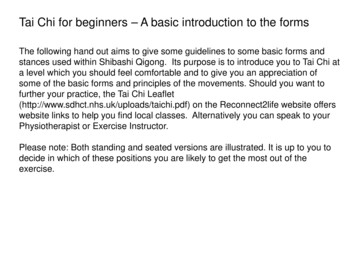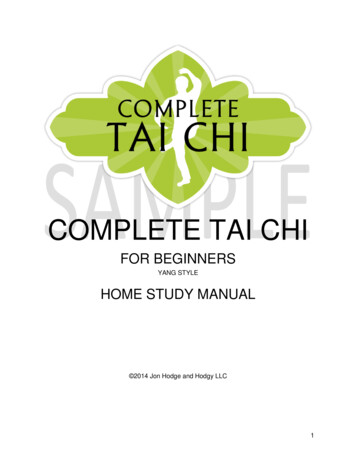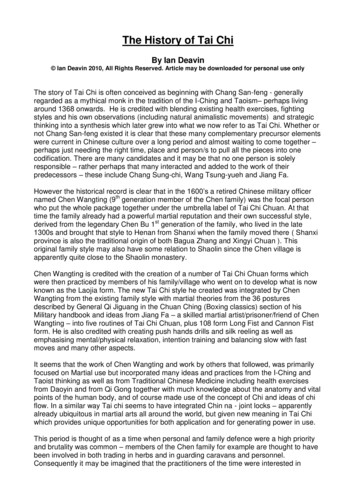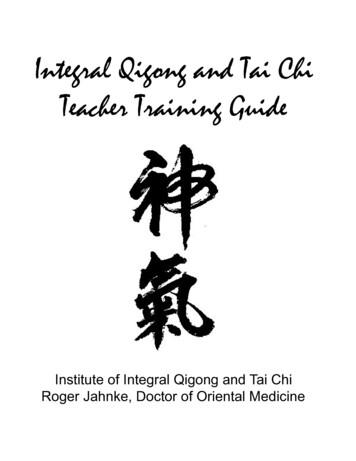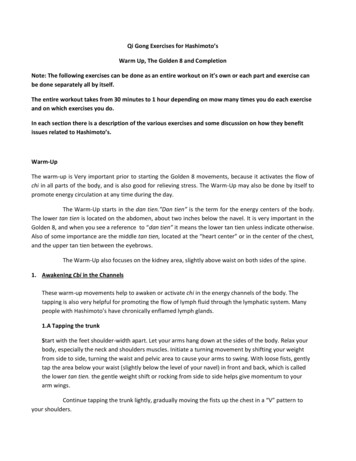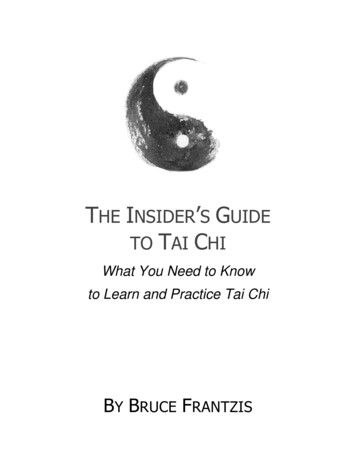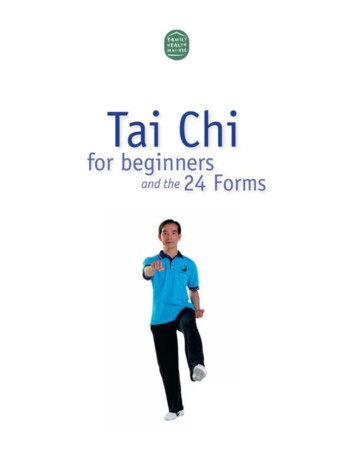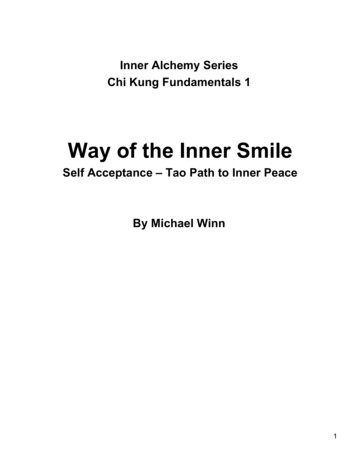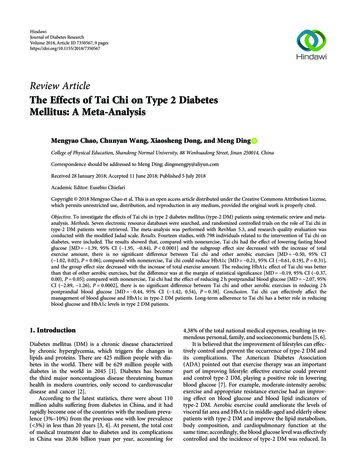
Transcription
HindawiJournal of Diabetes ResearchVolume 2018, Article ID 7350567, 9 pageshttps://doi.org/10.1155/2018/7350567Review ArticleThe Effects of Tai Chi on Type 2 DiabetesMellitus: A Meta-AnalysisMengyao Chao, Chunyan Wang, Xiaosheng Dong, and Meng DingCollege of Physical Education, Shandong Normal University, 88 Wenhuadong Street, Jinan 250014, ChinaCorrespondence should be addressed to Meng Ding; dingmengpy@aliyun.comReceived 28 January 2018; Accepted 11 June 2018; Published 5 July 2018Academic Editor: Eusebio ChiefariCopyright 2018 Mengyao Chao et al. This is an open access article distributed under the Creative Commons Attribution License,which permits unrestricted use, distribution, and reproduction in any medium, provided the original work is properly cited.Objective. To investigate the effects of Tai chi in type 2 diabetes mellitus (type-2 DM) patients using systematic review and metaanalysis. Methods. Seven electronic resource databases were searched, and randomized controlled trials on the role of Tai chi intype-2 DM patients were retrieved. The meta-analysis was performed with RevMan 5.3, and research quality evaluation wasconducted with the modified Jadad scale. Results. Fourteen studies, with 798 individuals related to the intervention of Tai chi ondiabetes, were included. The results showed that, compared with nonexercise, Tai chi had the effect of lowering fasting bloodglucose [MD 1.39, 95% CI ( 1.95, 0.84), P 0 0001] and the subgroup effect size decreased with the increase of totalexercise amount, there is no significant difference between Tai chi and other aerobic exercises [MD 0.50, 95% CI( 1.02, 0.02), P 0 06]; compared with nonexercise, Tai chi could reduce HbA1c [MD 0.21, 95% CI ( 0.61, 0.19), P 0 31],and the group effect size decreased with the increase of total exercise amount. The reducing HbA1c effect of Tai chi was betterthan that of other aerobic exercises, but the difference was at the margin of statistical significance [MD 0.19, 95% CI ( 0.37,0.00), P 0 05]; compared with nonexercise, Tai chi had the effect of reducing 2 h postprandial blood glucose [MD 2.07, 95%CI ( 2.89, 1.26), P 0 0002], there is no significant difference between Tai chi and other aerobic exercises in reducing 2 hpostprandial blood glucose [MD 0.44, 95% CI ( 1.42, 0.54), P 0 38]. Conclusion. Tai chi can effectively affect themanagement of blood glucose and HbA1c in type-2 DM patients. Long-term adherence to Tai chi has a better role in reducingblood glucose and HbA1c levels in type 2 DM patients.1. IntroductionDiabetes mellitus (DM) is a chronic disease characterizedby chronic hyperglycemia, which triggers the changes inlipids and proteins. There are 425 million people with diabetes in the world. There will be 629 million people withdiabetes in the world in 2045 [1]. Diabetes has becomethe third major noncontagious disease threatening humanhealth in modern countries, only second to cardiovasculardisease and cancer [2].According to the latest statistics, there were about 110million adults suffering from diabetes in China, and it hadrapidly become one of the countries with the medium prevalence (3%–10%) from the previous one with low prevalence( 3%) in less than 20 years [3, 4]. At present, the total costof medical treatment due to diabetes and its complicationsin China was 20.86 billion yuan per year, accounting for4.38% of the total national medical expenses, resulting in tremendous personal, family, and socioeconomic burdens [5, 6].It is believed that the improvement of lifestyles can effectively control and prevent the occurrence of type-2 DM andits complications. The American Diabetes Association(ADA) pointed out that exercise therapy was an importantpart of improving lifestyle: effective exercise could preventand control type-2 DM, playing a positive role in loweringblood glucose [7]. For example, moderate-intensity aerobicexercise and appropriate resistance exercise had an improving effect on blood glucose and blood lipid indicators oftype-2 DM. Aerobic exercise could ameliorate the levels ofvisceral fat area and HbA1c in middle-aged and elderly obesepatients with type-2 DM and improve the lipid metabolism,body composition, and cardiopulmonary function at thesame time; accordingly, the blood glucose level was effectivelycontrolled and the incidence of type-2 DM was reduced. In
2summary, exercise therapy has become an important part ofthe first level intervention of diabetes, which contributes tothe management of type-2 DM patients [8].The pathogenesis of type-2 DM is closely related to individual’s physical and mental state. The traditional exercise,Tai chi, is a combination of physical activity and respiration,which combines limb movement and mind, making peopleenjoying physical and mental pleasure while exercising [9].Therefore, Tai chi would play a more effective role in maintaining the body’s neuroendocrine balance and controllingblood glucose. Although some researchers have done someworks on the effects of Tai chi in type-2 DM patients usingsystematic evaluation and meta-analysis [10, 11], there aresome inadequacies, including limited number of subjectsand not typical enough detection indicators. In addition, asa form of physical and mental integration, whether Tai chihave more advantages beyond other aerobic exercises in themanagement of type-2 DM still lacks relevant mergedresearch evidence. Accordingly, it is necessary to further confirm the effects of Tai chi on type-2 DM by includingmore high-quality studies. Besides, although some studieshave explored the dose-response relationship betweenexercise and the incidence of type-2 DM using metaanalysis [12, 13], whether exercise, including Tai chi, hada dose-response relationship with blood glucose controlwas rarely studied. Therefore, this study also intends topreliminarily investigate the dose-response relationshipbetween the exercise amount of Tai chi and blood glucoselowering in type-2 DM patients using meta-analysis.2. Materials and Methods2.1. Data Sources and Search Strategies. Electronic resourcedatabases were searched, including PubMed, TheCochrane Library, EM base, SCI, CNKI, Wanfang Data,and VIP, and randomized controlled trials on the intervention effect of Tai chi on diabetes were retrieved. Thetime was all set as from the beginning to June 2016.Meanwhile, the references of the included papers were alsoreviewed to avoid omission. The search terms weredivided into two parts: target (diabetes) search and intervention measure (Tai chi) search, and adjusted accordingto each database. All the searches used a combination of thematic and free search; all search strategies were determinedafter multiple presearch. The search strategy was mainlybased on advanced search terms, including Tai chi, Taiji,Taijiquan, diabetes, type-2 diabetes mellitus, and DM.2.2. Inclusion and Exclusion Criteria. Inclusion criteriaincluded randomized controlled trials, published in Chinese and English language, with no restrictions on age orgender of type-2 DM; experimental group that takes Taichi as the major intervention in the exercise of type-2DM; the control group that does not take any exerciseor other aerobic exercises (aerobic exercise except traditional sports including Tai chi and Qigong: jogging, walking, etc.) or antiresistance exercises; and patients withoutserious DM-related complications.Journal of Diabetes ResearchExclusion criteria included experimental groups thatused voluntary grouping principles and other nonrandomized controlled experiments; studies that did not includeindicators to be discussed in this study; experimental groupsthat used other main exercises excluding Tai chi; and patientwith DM-related complications.2.3. Trial Inclusion and Data Extraction. During the process,two researchers (M. C. and X. D.) independently completedthe trial inclusion and data extraction, and in case of disagreements, the third researcher (M. D.) would determine whetherto include and extract. Data extraction information includedinformation of the first author, publication time, publishedjournals, title of trials, intervention measures of the experimental group and the control group, intervention time, subject number of the experimental group and the controlgroup, whether outcome indicator was complete, whetherthere were subjects lost to follow-up, and basic informationof patients (age, gender, sex ratio, and whether there wereother complications). Diabetes indicator data included fastingblood glucose (FBG), HbA1c, and 2 h postprandial blood glucose (2hPBG); FBG was the first indicator of this study.2.4. Trial Quality Assessments. During the data extractionprocess, the quality of the included studies was evaluatedusing modified Jadad quality scoring scale [14]. ModifiedJadad quality scoring scale included the generation of random sequences, distribution methods, randomized concealment, whether blind method was adopted, and so on. Therewere corresponding criteria and scores for each item, 1–3points for low-quality study and 4–7 points for high-qualitystudy. Two raters performed the quality assessment independently (M. C. and C.W.). Disagreements were resolved byseeking the opinion of the third rater (M. D.)2.5. Statistical Analysis. Meta-analysis was performed withReview Manager 5.3 available from Cochrane. The heterogeneity test χ2 of the results was included. When there was statistical homogeneity between studies, it was shown in P 0 1and I 2 50% and a fixed-effect model was used; the heterogeneity was shown in P 0 1 and I 2 50%, and heterogeneitysource analysis was performed, then subgroup analysis wasconducted based on the heterogeneity. If there was no heterogeneity between subgroups, a fixed-effect model was used,while if there was heterogeneity between subgroups, themeta-analysis was performed with a random-effect model;if the heterogeneity within the group was too large, descriptive analysis was carried out.To reveal whether there was a dose-response relationshipbetween Tai chi with blood glucose control and HbA1c lowering in type-2 DM patients, Tai chi and nonexercise in theincluded studies were compared based on total exerciseamount, and stratified subgroup analysis was performed inthis study. Since most of the selected studies did not reportTai chi exercise intensity, the exercise intensity of allselected studies was treated as the same by default; thus,the total exercise amount could be expressed by total exercise time. According to total exercise amount, the includedstudies were divided into 4 subgroups, namely, small
Journal of Diabetes Research3Records identified throughdatabase searching (n 171)Records after duplicates removed(n 73)Record screened (n 73)Full-text articles assessedfor eligibility (n 33)40 records excluded on the basisof title and abstractnot related with diabetes (n 27)Not RCT (n 10)The same research (n 3)19 full-text articles excludedreviews (n 13)Incomplete experimental date(n 6)Studies in conformity with theinclusion criteria (n 14)Figure 1: Flowchart of trial selection process.exercise group (with exercise amount less than 1999minutes), medium exercise group (with exercise amount of2000–3999 minutes), large exercise group (with exerciseamount of 4000–5999 minutes), and super large exercisegroup (with exercise amount above 6000 minutes). The totalexercise amount was calculated as total exercise amount(minutes) Tai chi exercise time (minutes) per day Taichi exercise days per week total of Tai chi exercise weeks(calculated as 4 weeks per month).3. Results3.1. Trial Search. Databases, including PubMed, TheCochrane Library, EMbase, SCI, CNKI, Wanfang Data, andVIP, were searched, and according to the criteria of exclusionand inclusion, randomized controlled trials on the intervention of Tai chi on type-2 DM were retrieved. A total of 171potentially relevant articles were identified by the databasesearches. After excluding duplicates, 73 records remained.Of these, 40 articles were removed through reading titlesand abstracts and 19 were excluded after reviewing the fulltext against the eligibility criteria. Finally, a total of 14 trials[15–27], including 5 English ones and 9 Chinese ones, wereincluded. One trial titled “Health Qigong Tai Ji Quan Adjuvant Therapy in Patients with Type 2 Diabetes Clinical Observational Studies” is an unpublished literature, which wasretrieved from the Doctoral and Master Dissertation Libraryof CNKI. The study selection process is shown in Figure 1.3.2. Characteristics of Included Studies and QualityAssessments. Fourteen studies, with 798 individuals relatedto the intervention of Tai chi on diabetes, were included.The average age ranged 48.0–64.0. All patients in intervention groups received Tai chi intervention while maintainingroutine medication. Seven articles have adopted the 24-style(short form) Tai chi [17, 18, 22, 23, 25, 27, 28], 1 articleadopted the 24-form Yang TC style [19], 1 article adoptedYang and Sun 20-form TC style [20], 1 article adopted theLin Housheng’s style [24], 1 article adopted the DaYuan’sTC style [15], 1 article adopted the Yang TC style [21], and2 articles did not report the type of Tai chi [16, 26]. The frequencies of Tai chi exercise in the included articles were from3 to 7 times per week, and exercise durations lasted from 15to 60 minutes across the different articles. The control groupswere divided into nonexercise groups and other aerobic exercise groups. The exercise forms of other aerobic exercisegroups include social dance, Qigong, and general aerobicexercise (see Table 1 for details). In the case of modifiedJadad scoring, there were 6 studies with 2 points, 5 studieswith 3 points, 2 studies with 5 points, and 1 study with 6points. There were 11 low-quality trials, with an average of2.4 points, and 3 high-quality trials, with an average of 5.3points (see Table 2 for details).3.3. Outcomes3.3.1. Fasting Blood Glucose(1) Tai Chi versus Nonexercise. Initially, the data of 11 relatedstudies (n 529) [15, 17, 23–27] was pooled, but the data heterogeneity was quite high. After subgroup analysis accordingto total exercise amount, it was found that the heterogeneityof 4 studies in a large exercise group was as high as 94%.Through sensitivity analysis of the data, it was speculated
4Journal of Diabetes ResearchTable 1: Characteristics and quality assessments of the included trials.First author, yearPatients(total, E/C)Yan 2004Yu 2004Jiang 2007Tracey T. 2007Paul Lam 2008Ying Zhang 200818, 10/840, 20/2036, 18/1838, 18/2053, 28/1520, 10/9Wang 200954, 28/26Wu 2010Shih-ChuenChen 2010Li X. 2013Li Z. 201387, 43/44Sununta 201364, 32/32Tang 201428, 14/14Tang 201429, 15/14Tang 201427, 13/14Zhang 2015100, 50/50Age (mean (SD), E/C)ExperimentalinterventionTai chiTai chiTai chiTai chiTai chiTai chi40, 20/2051.8 (7.4)/53.1 (7.8)50 (58)/49 (5.6)57.2 (4.2)/55.0 (6.2)65 (7.8)63.2 (8.6)/60.7 (12.2)57.4 (6.2)49.21 (11.12)/48.83(10.54)NR104, 56/4860, 30/30ControlDuration, sessions with supervision per week,time per session24 weeks, 7, 40 min12 weeks, 7, 60 min20 weeks, 7, 40 min16 weeks, 2, 60 min24 weeks, 2, 60 min14 weeks, 5, 60 minTai chiNNNNNNSocial dancingexerciseN59.1 (6.2)/57.4 (5.8)Tai chiAerobic exercise12 weeks, 3, 60 min57.3 (10.3)54.21 (9.47)/52.69(8.37)NR61.40 (5.08)/61.53(6.23)62.73 (7.17)/61.53(6.23)59.40 (6.68)/61.53(6.23)55.36 (2.78)/61.53(6.23)Tai chiN8 weeks, 7, 45 minTai chiN12 weeks, 7, 30 minTai chiN12 weeks, 5, 30 minTai chiN24 weeks, 5, 15 minTai chiN24 weeks, 5, 30 minTai chiN24 weeks, 5, 45 minTai chiN4 weeks, 7, 30 minTai chi24 weeks, 5, 30 min24 weeks, 3, 60 minE: experimental group; C: control group; N: nonexercise; NR: not reported; min: minute; SD: standard deviation.that the data of Yu 2004 was the main source of heterogeneity in this subgroup. Accordingly, the data of this studywas excluded, and the data of the other 3 studies waspooled. Finally, the data of 10 studies (n 489) waspooled, and the results showed that, compared with nonexercise, Tai chi had an effect of lowering FBG and thatthe difference was statistically significant [MD 1.39, 95%CI ( 1.95, 0.84), P 0 0001]. Within 6000-minute exerciseamount, the subgroup pooled effect size decreased with theincrease of total exercise amount, and only one study wasincluded above 6000 minutes, its effect size was close to thegroup of 4000–5999 minutes and the difference was notstatistically significant (see Figure 2).total exercise amount, it was found that the heterogeneity wasmainly from the large exercise group. After sensitivity analysis, it was speculated that the data of Jiang 2007 and Wu 2010was the main source of heterogeneity. Accordingly, the dataof these two studies was excluded, and data pooling wasreperformed. Finally, data pooling was carried out for 7studies (n 293), and the results showed that HbA1c inthe Tai chi group was lower than that in the control group,with statistically significant difference [MD 0.73, 95% CI( 0.95, 0.52), P 0 03]. The grouping effect size of HbA1cdecreased with the increase of total exercise amount (seeFigure 4).(2) Tai Chi versus Other Aerobic Exercises. As shown inFigure 3, 7 related studies (n 342) [18, 21, 22, 25] allowedfor data pooling. After data pooling using a random-effectmodel, the results suggested that, compared with other aerobic exercises, Tai chi did not show a better role in loweringFBG, and the difference was not statistically significant[MD 0.21, 95% CI ( 0.61, 0.19), P 0 31].(2) Tai Chi versus Other Aerobic Exercises. As shown inFigure 5, 7 related studies (n 372) [19, 21, 22, 25]allowed for data pooling. After data pooling using arandom-effect model, the results suggested that, comparedwith other aerobic exercises, Tai chi had a better effect ofreducing HbA1c and that the difference was statisticallysignificant [MD 0.19, 95% CI ( 0.37, 0.00), P 0 05].However, the statistical significance was at the margin.3.3.2. HbA1c3.3.3. Two-Hour Postprandial Blood Glucose(1) Tai Chi versus Nonexercise. Initially, the data of 9 studies (n 356) [15, 16, 24, 25] was pooled, but the data heterogeneity was quite high. After subgroup analysis according to(1) Tai Chi versus Nonexercise. As shown in Figure 6, 5related studies (n 162) [15, 26] allowed for data pooling.After data pooling using a random-effect model, the results
Journal of Diabetes Research5Table 2: The quality evaluation of the methodology.Inclusion researchRandomizationConcealment of allocationDouble blindingWithdrawals and dropoutsJadad oNoNoComputer generationNoNoNoNoNoNoNoNoNoNoNoNoDouble blindDouble blindNoNoNoNoNoNoDouble 332323532Yan 2004Yu 2004Jiang 2007Tracey T. 2007Paul Lam 2008Ying Zhang 2008Wang 2009Wu 2010Shih-Chuen Chen 2010Li X. 2013Li Z. 2013Sununta 2013Tang 2014Zhang 2015Study or subgroupMean (mmol/L)Tai chiTotalSD (mmol/L)1.1.1 Small exercise groupSununta 2013 0.570.59Tang 2014 0.11.07Zhang 2015 1.341.56Subtotal(95%CI)IHeterogenity: Tau2 0.00; Chi2 1.74, df 2 (P 0.42); I2 0%Test for overall effect: Z 4.51 (P 0.00001)1.1.2 Medium exercise group1.59 3.14Li X. 20131.47 1.6Li Z. 20130.6 1.01Tang 2014Subtotal (95% CI)Heterogenity: Tau2 0.00; Chi2 1.57, df 2 (P 0.42); I2 0%Test for overall effect: Z 5.44 (P 0.00001)NonexerciseMean differenceTotal WeightMean (mmol/L) SD (mmol/L)IV, random, 95% CI (mmol/L)32145096 0.110.34 0.510.61.140.763214509612.6%10.1%11.9%34.5% 0.46 [ 0.75, 0.17] 0.44 [ 1.26, 0.38] 0.83 [ 1.31, 0.35] 0.55 [ 0.79, 0.31]30431588 2.44 0.460.341.491.571.143044148810.3%11.1%10.9%32.3% 0.70 [ 1.48, 0.08] 1.15 [ 1.79, 0.51] 1.35 [ 2.02, 0.68] 1.10 [ 1.50, 29.9% 0.70 [ 1.48, 0.08] 1.15 [ 1.79, 0.51] 1.35 [ 2.02, 0.68] 1.10 [ 1.50, 0.71] 3.92.76883.2%3.2% 2.05 [ 4.72, 0.62] 2.05 [ 4.72, 0.62]244100.0% 1.39 [ 1.95, 0.84]1.1.3 Large exercise group181.75 3.29Jiang 2007130.54 1.84Tang 2014201.16 2.09Wu 201051Subtotal (95% CI)222Heterogenity: Tau 0.20; Chi 4.37, df 2 (P 0.11); I 54%Test for overall effect: Z 7.20 (P 0.00001)1.1.4 Super large exercise group 5.95Yan 2004Subtotal (95% CI)Heterogenity: not applicableTest for overall effect: Z 1.51 (P 0.13)31010245Total (95% CI)Heterogenity: Tau2 0.61; Chi2 62.08, df 9 (P 0.00001); I2 86%Test for overall effect: Z 4.96 (P 0.00001)Test for subgroup differences: Chi2 31.44, df 3 (P 0.0001) , I2 90.5%Mean differenceIV, random, 95% CI (mmol/L) 4 2024Favours [Tai chi] Favours [nonexercise]Figure 2: The meta-analysis for comparing FBG between Tai chi and the nonexercise. CI: confidence interval; SD: standard deviation.suggested that the 2hPBG in the Tai chi group was lowerthan that in the nonexercise group and that the differencewas statistically significant [MD 2.07, 95% CI ( 2.89, 1.26), P 0 0002].(2) Tai Chi versus Other Aerobic Exercises. As shown inFigure 7, for 3 related studies (n 84), after data poolingusing a random-effect model, the results showed that therewas no statistically significant difference in 2hPBG betweenthe Tai chi group and the other aerobic exercise group[MD 0.44, 95% CI ( 1.42, 0.54), P 0 38].3.4. Publication Bias Evaluation3.4.1. Publication Bias Evaluation between Tai Chi andNonexercise. In this study, funnel plot analysis was performed on the indicator, FBG, in the Tai chi group andthe nonexercise group. A total of 11 studies, with 529subjects, were included. The results showed that the distribution of included studies on both sides of the funnelplot was asymmetric, indicating that there might bepotential publication bias in the comparison of Tai chiand nonexercise.
6Journal of Diabetes ResearchTai chiOther aerobic exerciseMean differenceStudy or subgroupTotalTotal WeightMean (mmol/L) SD (mmol/L)Mean (mmol/L) SD (mmol/L)IV, random, 95% CI (mmol/L)2.1.1 FBG43 0.32 [ 0.96, 0.32]48 15.0%1.661.46 1.29 1.61Li Z. 2013 0.14 [ 0.58, 0.30]50Shih-Chuen Chen 201044 18.9%1.031.15 0.21 0.350.59 [ 0.18, 1.36]1414 12.8%1.011.07 0.69 0.1Tang 2014 0.32 [ 0.93, 0.29]1514 15.6%1.010.6 0.69 1.01Tang 2014Tang 20141314 15.7%1.010.54 0.69 1.48 0.79 [ 1.40, 0.18]Wang 20092826 18.2%1.711.05 0.86 0.580.28 [ 0.20, 0.76]103.8%92.391.67 0.08 2.3Ying Zhang 2008 2.22 [ 4.09, 0.35]Subtotal (95% CI)173169 100.0% 0.21 [ 0.61, 0.19]Heterogeneity: Tau2 0.17; Chi2 16.25, df 6 (P 0.01); I2 63%Test for overall effect: Z 1.02 (P 0.31)Total (95% CI)173Heterogeneity: Tau2 0.17; Chi2 16.25, df 6 (P 0.01); I2 63%Test for overall effect: Z 1.02 (P 0.31)Test for subgroup differences: not applicable169100.0%Mean differenceIV, random, 95% CI (mmol/L) 0.21 [ 0.61, 0.19] 4 2Favours [Tai chi]024Favours [other aerobic e]Figure 3: The meta-analysis for comparing FBG between Tai chi and other aerobic exercises. CI: confidence interval; SD: standard deviation.Study or subgroupTai chiMean (%)SD (%)TotalNonexerciseMean (%)SD (%)TotalWeightMean differenceIV, random, 95% CI (%)Mean differenceIV, random, 95% CI (%)1.2.1 Small exercise group 1.071.0332Sununta 2013Tang 2014 0.250.381446Subtotal (95% CI)Heterogeneity: Tau2 0.00; Chi2 0.77, df 1 (P 0.38); I2 0%Test for overall effect: Z 4.61 (P 0.00001) 0.260.281.250.373214469.6%19.2%28.9% 0.81 [ 1.37, 0.25] 0.53 [ 0.81, 0.25] 0.59 [ 0.83, 0.34] 0.820.281.470.374414588.5%19.9%28.4% 0.90 [ 1.52, 0.28] 0.37 [ 0.63, 0.11] 0.56 [ 1.06, 0.06]0.28 0.30.370.2714203419.1%20.1%39.3% 0.81 [ 1.37, 0.25] 0.53 [ 0.81, 0.25] 0.59 [ 0.83, 0.34] 1.91.17883.5%3.5% 1.20 [ 2.28, 0.12] 1.20 [ 2.28, 0.12]146100.0% 0.73 [ 0.95, 0.52]1.2.2 Medium exercise group 1.721.4643Li Z. 2013Tang 2014 0.090.3515Subtotal (95% CI)58222Heterogeneity: Tau 0.08; Chi 2.41, df 1 (P 0.12); I 58%Test for overall effect: Z 2.20 (P 0.03)1.2.3 Large exercise groupTang3 2014Yu 2004Subtotal (95% CI) 0.66 1.20.370.52 3.11.15132033Heterogeneity: Tau2 0.00; Chi2 0.04, df 1 (P 0.84); I2 0%Test for overall effect: Z 9.52 (P 0.00001)1.2.4 Super large exercise groupYan 2004Subtotal (95% CI)1010Heterogeneity: not applicableTest for overall effect: Z 2.18 (P 0.03)Total (95% CI)147Heterogeneity: Tau2 0.04; Chi2 14.04, df 6 (P 0.03); I2 57%Test for overall effect: Z 6.69 (P 0.00001)Test for subgroup diffrences: Chi2 5.75, df 3 (P 0.12), I2 47.8% 2 110Favours [Tai chi]2Favours [nonexercise]Figure 4: The meta-analysis for comparing HbA1c between Tai chi and the nonexercise. CI: confidence interval; SD: standard deviation.Study or subgroupTai chiMean (%) SD (%)Total2.2.1 Hba1C1.4643Li Z. 2013 1.721.6250 0.6Shih-Chuen Chen 2010Tang 20140.3814 0.250.3515 0.09Tang 2014Tang 20140.3713 0.660.417 0.07Tracey Tsang 20070.3828 1.03Wang 2009180Subtotal (95% CI)22Heterogeneity: Tau 0.04; Chi 16.93, df 6 (P 0.010); I2 65%Test for overall effect: Z 1.96 (P 0.05)180Total (95% CI)Heterogeneity: Tau2 0.04; Chi2 16.93, df 6 (P 0.010); I2 65%Test for overall effect: Z 1.96 (P 0.05)Test for subgroup differences: not applicableOther aerobic exerciseMean (%) SD (%) 1.34 0.3 0.1 0.1 0.10.12 1.081.472.240.30.30.30.30.46Total WeightMean differenceIV, random, 95% CI .1%100.0% 0.38 [ 0.98, 0.22] 0.30 [ 1.10, 0.50] 0.15 [ 0.39, 0.09]0.01 [ 0.21, 0.23] 0.56 [ 0.80, 0.32] 0.19 [ 0.44, 0.06]0.05 [ 0.18, 0.28] 0.19 [ 0.37, 0.00]192100.0% 0.19 [ 0.37, 0.00]Mean differenceIV, random, 95% CI (%) 1 0.5Favours [Tai chi]00.51Favours [other aerobic e]Figure 5: The meta-analysis for comparing HbA1c between Tai chi and other aerobic exercises. CI: confidence interval; SD:standard deviation.
Journal of Diabetes ResearchStudy or subgroup7NonexerciseMean differenceTai chiTotal WeightTotalMean (mmol/L) SD (mmol/L)IV, random, 95% CI (mmol/L)Mean (mmol/L) SD (mmol/L)1.3.1 2 hPBGLi X. 2013 6.253.230Tang 2014 1.862.9414Tang 2014 2.542.3515 2.651.5713Tang 2014 7.14.7610Yan 201482Subtotal (95% CI)Heterogeneity: Tau2 0.00; Chi2 1.17, df 4 (P 0.88); I2 0%Test for overall effect: Z 4.99 (P 0.00001) 4.82 0.15 0.15 0.15 4.93.452.242.242.244.49Total (95% CI)82Heterogeneity: Tau2 0.00; Chi2 1.17, df 4 (P 0.88); I2 0%Test for overall effect: Z 4.99 (P 0.00001)Test for subgroup diffrences: not % 1.43 [ 3.11, 0.25] 1.71 [ 3.65, 0.23] 2.39 [ 4.06, 0.72] 2.50 [ 3.95, 1.05] 2.20 [ 6.49, 2.09] 2.07 [ 2.89, 1.26]80100.0% 2.07 [ 2.89, 1.26]Mean differenceIV, random, 95% CI (mmol/L) 4 2024Favours [Tai chi] Favours [nonexercise]Figure 6: The meta-analysis for comparing 2hPBG between Tai chi and the nonexercise. CI: confidence interval; SD: standard deviation.Study or subgroupTai chiMean (mmol/L) SD (mmol/L)Total2.3.1 2hPBGTang 2014 1.862.9414Tang 2014 2.542.3515Tang 2014 2.651.571342Subtotal (95% CI)Heterogeneity: Tau2 0.00; Chi2 0.42, df 2 (P 0.81); I2 0%Test for overall effect: Z 0.88 (P 0.38)Other aerobic exerciseTotalMean (mmol/L) SD (mmol/L) 1.98 1.98 1.982.362.362.36Total (95% CI)42Heterogeneity: Tau2 0.00; Chi2 0.42, df 2 (P 0.81); I2 0%Test for overall effect: Z 0.88 (P 0.38)Test for subgroup differences: not applicableWeightMean differenceIV, random, 95% CI (mmol/L)1414144224.7%32.7%42.6%100.0%0.12 [ 1.85, 2.09] 0.56 [ 2.28, 1.16] 0.67 [ ,17, 0.83] 0.44 [ 1.42, 0.54]42100.0% 0.44 [ 1.42, 0.54] 2Mean differenceIV, random, 95% CI (mmol/L) 1012Favours [Tai chi] Favours [other aerobic e]Figure 7: The meta-analysis for comparing 2hPBG between Tai chi and other aerobic exercises. CI: confidence interval; SD:standard deviation.3.4.2. Publication Bias Evaluation between Tai Chi and OtherAerobic Exercises. Funnel plot analysis was performed on theindicator, FBG, in the Tai chi group and the other aerobicexercise group. A total of 7 studies, with 342 subjects, wereincluded. The results showed that the distribution ofincluded studies on both sides of the funnel plot was asymmetric, indicating that there might be potential publicationbias in the comparison of Tai chi and other aerobic exercises.4. DiscussionTai chi is one of the unique traditional exercises in China. Inthe practice of Tai chi, it is required to be concentrated, moveslowly, and be tranquil in movement. The intensity is not sohigh, and adequate physical and mental relaxation can beachieved. Thus, Tai chi is fit for older people with weakerconstitution and chronic diseases, which is a moderate general movement. Theoretically, Tai chi should be a suitableexercise for type-2 DM patients. However, there were contradictions in published systematic review and meta-analysis.Zhang Yeting and others included 4 studies and systematically reviewed the effect of Tai chi in type-2 DM patientsbefore and after exercise; the results showed that there wasa significant decrease of blood glucose level in type-2 DMpatients after Tai chi exercise, indicating the effect of Taichi on diabetes, while two meta-analysis researches publishedin 2013 and 2015 [10, 11] considered that there was still nosufficient evidence to confirm the blood glucose loweringeffect of Tai chi in type-2 DM patients.However, according to the results of this study, compared with nonexercise, Tai chi had significant decreasingeffect on FBG, HbA1c, and 2hPBG among type-2 DMpatients, indicating that Tai chi had a positive effect fordiabetics. Theoretically, as a regular small- and mediumintensity aerobic exercise, Tai chi can promote the metabolism of cells and tissues, promote blood back-flowing tothe heart, improve body’s utilization of glucose, increasetarget cell reactivity, improve body’s glucose tolerance,prevent the composition of HbA1c, and accelerate thecombination of hemoglobin and oxygen. Therefore, theblood glucose can be further controlled, thereby reducingthe levels of FBG, HbA1c, and 2hPBG.From the results of this study, compared with otheraerobic exercise, including running, walking, and dancing,Tai chi did not sh
Tai chi, is a combination of physical activity and respiration, which combines limb movement and mind, making people enjoying physical and mental pleasure while exercising [9]. Therefore, Tai chi would play a more effective role in main-taining the body’s neuroendocrine balance and cont
